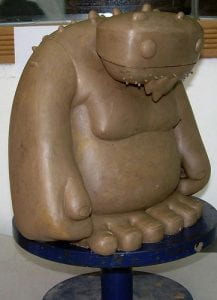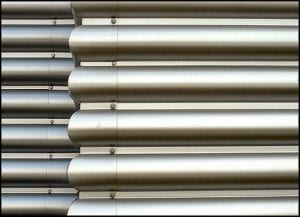Hi everyone and welcome back to my blog!
Having collected action figures for some time, I was really interested in learning about the complicated process of how they are designed and made. Recently, I started taking an environmental perspective on this process. I was aware that just like any other manufactured goods, action figures have a carbon footprint. But I had two questions: “How big?” and “Is it being minimized?” I scoured the internet for answers.
My search revealed three types of materials commonly used to produce an action figure: wax, steel and resin.
A Waxy Redemption

Wax is generally used in the initial design phase. Here, sculptors create the general aesthetic and mould of an action figure, using a material distilled straight from crude oil (Vanis,2018). According to Gadalla et al (2006)., this distillation process is energy-intensive, producing large amounts of carbon emissions that are detrimental to the environment.
Thankfully, most manufacturers have done away with wax, turning to 3D modelling software instead. The process is by no means emissions free, but it does increase the efficiency of the design phase, requiring fewer materials for mould-making and less time for completion. Here, in this virtual space, the miniaturization of your favourite fictional characters takes place with stunning precision and detail! A win-win for both the collector and the environment!
Want to find out more about 3D printing? Check out this great youtube video!
A Steely Sin

Despite this green move, the action figure industry is far from spotless. To mass produce toys, most companies utilise steel injection moulds to craft individual limbs and accessories (Vanis,2018). These durable moulds help streamline the production process so that these toys can be received by overeager science fiction fans! The problem is the steel.
From its mineral extraction to its blast-furnace manufacturing, this ubiquitous material is a much bigger carbon emitter than wax, accounting for 7 to 9% of emissions from worldwide fossil fuel burning, according to World Steel Association. Not a win for the environment.
Rise of Resin
Last but certainly not least, is resin. More specifically, urethane resin. This material is the final form in which your miniaturized hero (or villain) will take shape. This tough but malleable material can easily be molded to capture even the most miniscule of details! Unfortunately, much like the rest of its plastic cousins, urethane resin has a massive carbon footprint. Like steel, it is derived from fossil fuels through a series of energy-intensive chemical reactions. Its tough composition also means that like plastic bags, it is non-biodegradable. So, when discarded, these plastics can take up to a millennium to breakdown.
But please don’t discard your action figures! It’s better to donate or do something creative with them!
Wow! Who knew that a six-inch scale stormtrooper could be so detrimental to the environment? It’s a little mind-boggling that a seemingly innocent hobby could have such far-reaching consequences on our planet! This post has definitely given me a lot to reflect on and I hope you have found it as insightful as I have!
Thank you and till next time!
References
Vanis, M. (2018, April 2). How are action figures made? The toy pre-production process. Retrieved from The Toy Archives: https://thetoyarchives.com/blog/how-are-action-figures-made/
World Steel Association. (2020). STEEL’S CONTRIBUTION TO A LOW CARBON FUTURE AND CLIMATE RESILIENT SOCIETIES. Retrieved from worldsteel.org: https://www.worldsteel.org/en/dam/jcr:7ec64bc1-c51c-439b-84b8-94496686b8c6/Position_paper_climate_2020_vfinal.pdf
greenspec. (2020). Steel production and environmental impact. Retrieved from greenspec: https://www.greenspec.co.uk/building-design/steel-products-and-environmental-impact/
greenspec. (2020). Steel production & environmental impact . Retrieved from greenspec: https://www.greenspec.co.uk/building-design/steel-products-and-environmental-impact/
Warren, C. (2012, April 23). Industrial Resins and the Environment. Retrieved from howstuffworks: https://science.howstuffworks.com/environmental/green-science/industrial-resins2.htm
ThoughtCo. (2020). How Long Does It Take Garbage to Decompose? Retrieved from Environmental Issues: http://storage.neic.org/event/docs/1129/how_long_does_it_take_garbage_to_decompose.pdf
M.Gadella, C. (2006, October). Estimation and reduction of CO2 emissions from crude oil distillation units. Retrieved from ScienceDirect: https://www-sciencedirect-com.libproxy1.nus.edu.sg/science/article/pii/S0360544205002288



Hi Joseph,
It’s really eye opening to know about the different materials used in toy making. I never knew that there is so much going behind the production of a toy! I think the use of 3D modelling is a good application to make toys as it reduces the need for wax. However, do you think that there are limitations of using 3D modelling, that make wax sculptures still necessary or still a better choice than 3D modelling?
– Jo
Hey Jo! Thanks for the question. From a consumer’s standpoint, I would say that 3D modelling is the way to go! Mainly because figures made via this process tend to look more accurate to their respective characters. I find this to be especially true for head sculpts of actors, 3D modelling is great at capturing their likeness. I guess a possible limitation for it would be the electronic waste generated if the 3D modelling computer hardware breaks down. I have not come across any concrete evidence that such hardware is recycled and if it is just discarded it would be detrimental to the environment, as we saw in week 4 lecture on soil quality .
Hi Joseph,
To build on Jo’s Q & your reply… I was thinking – besides the e-waste issue, what about the carbon & water footprints of 3D modeling ? Meaning, OK, you do away with the wax model, but isn’t there still an environmental impact to using these huge 3D printers and powering your computer the entire time you’re designing the mould ? You may not easily find the exact answer, but I’m wondering how you might go about figuring this out. Pls don’t spend too much time answering me.
Thanks,
jc
Hi Doctor Coleman!
Thank you for the question, it is quite difficult to find articles relating to the carbon and water footprint of 3D modelling and printing. One of the most related articles I found actually looked at particle and pollutant emissions of 3D printing (https://www-sciencedirect-com.libproxy1.nus.edu.sg/science/article/pii/S1352231013005086?via%3Dihub).
I guess a good framework for tallying the carbon and water footprints of 3D modelling/printing would be to split it into two phases.
First phase (Production): This would measure the C02 emitted and the total amount of virtual water needed to manufacture the 3D printing equipment e.g. computer chips, wires.
Second phase (Ongoing operations): This would measure the C02 emitted and the total amount of virtual water needed for producing the 3D printed product e.g. raw materials like resin, electricity needed to power to computers and printers.
Thank you!,
Joseph